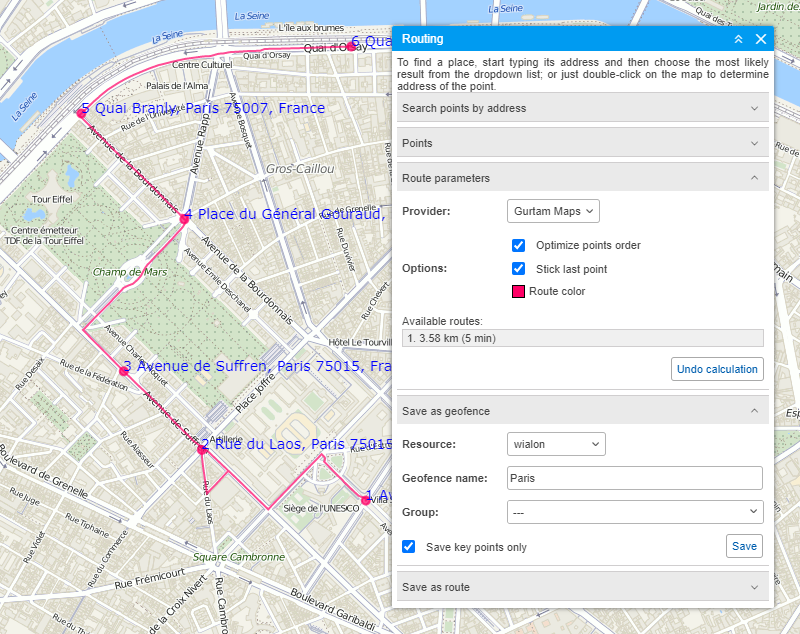Routing
This tool allows quickly mapping the shortest routes from one point to another with a visit to any number of intermediate points. You can specify the order of points manually or use the order proposed by the tool. You can indicate key points by double-clicking on the map or entering the required addresses. The resulting route can be saved as a geofence with or without control points or as a route and can be used for route or geofence control later on.
To open the tool, click on the icon  in the top panel and select the Routing item. Specify the required parameters and click Calculate.
in the top panel and select the Routing item. Specify the required parameters and click Calculate.
Selecting a provider
Gurtam Maps is a default cartographical service used to map a route (you can select it in the Route parameters section, the Provider field). In addition, depending on the available maps, you can select other map providers, such as Google Maps, HERE, or Namaa. However, if you use these maps, you should choose the order of points manually (or predetermine it by Gurtam Maps). If you use Gurtam Maps, additional options are available: selection of the transportation mode, creation of a route avoiding highways, etc. Namaa maps allow you to select the traffic scheme (plan) that should be taken into account when planning a route.
Placing points
The ways to set key points for a route are described below.
Using the mouse
Just make several double-clicks on the map to indicate the key points. If the Use detected addresses as names for points option is enabled in the Points section of the window, the addresses are automatically registered as point names. If the address information is missing, the point is added anyway, but without a name.
Using the address tool
In the Address section of the window, indicate the addresses of the points you want to visit. The usage of the Address tool was described in detail in the previous section. The indicated points can be added to the route automatically if the Auto save of points option is enabled, or manually (by clicking on the Add point button) if the option is disabled.
If you are going to use this route for route control, it is recommended to choose the starting point of the unit to which this route will be assigned as the first point.
When at least two points are set, it is possible to draw the route. To do this, click on the Calculate button. Note that you might want to pre-edit key points, especially if you are going to save this route as a geofence or as a route.
The list of points is displayed in the Points section of the window. Here you can change the order of points, edit their names and radius, and delete them.

Route calculation
The route calculation allows you to map a route between points taking into account the existing roads.
When mapping a route with Gurtam Maps, you can use a different sequence of route points:
- If you want points to follow the sequence used on the map, do not enable any additional options.
- To map the shortest route, enable the Optimize points order option. In this case, the sequence of all points except the first one may change if it allows shortening the route. If you want the last indicated point to be the last point in the calculated route, enable the Stick last point option.
In addition, you can select the colour of the route line.
After configuring the required parameters, click on the Calculate button. After that, you can see a list of the available routes based on the indicated points in the Route parameters section. The length and approximate duration are specified for each of them. Click on the route in the list to view it on the map. Now you can select the most appropriate route and save it.
If you want to change some parameters (for example, add more points), click Undo calculation. If you want to map a new route, remove all the indicated points in the Points section.
If the calculation is made using routing, the route is built taking into account the existing roads. Gurtam Maps is supported as the default routing provider for this tool.

Saving as a geofence or route
After mapping the route, you can save the result as a line-shaped geofence or as a route. By default, the Save as geofence section opens automatically after the calculation. Here you should enter the geofence name, select the resource and the geofence group (if you want to include the created geofence in an existing group), and click Save.
There are two options for saving the route:
- If the Save key points only option is enabled, the geofence will correspond to the line passing along the shortest path through the points of the route.
- If the option is disabled, the geofence will correspond to the entire line of the route.
The created geofence is saved on the Geofences tab where you can edit it.
The result can also be saved as a route. To do this, expand the corresponding section, indicate the name for the route, and click Save. The created route is available on the Routes tab where you can edit it.
The route saved in this way does not correspond to existing roads.
To plan routes, you can also use the Logistics application.